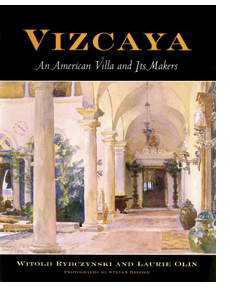Portrait of a South Florida masterpiece.

VIZCAYA: An American Villa and its Makers
Witold Rybczynski and Laurie Olin, faculty, with photographs by Steven Brooke. University of Pennsylvania Press, 2006. $34.95.
By Beth Kephart | In 1910, James Deering—49 years old, recently retired from active duties at the family concern (the International Harvester Company), and spectacularly wealthy—embarked on what would soon become one of the greatest adventures in villa design the United States had ever seen. His chosen territory was Coconut Grove, along South Florida’s Biscayne Bay. His aspiration was to create for himself a winter home of spectacular scope, European flair, and ecological sensitivity. His method was to hire, as his artistic adviser, a brilliant painter by the name of Paul Chalfin. Throughout Europe Deering and Chalfin traveled—taking in sights, pondering Italian gardens and Spanish rooflines, and buying up historic artifacts, all in anticipation of a place that would one day be known as Vizcaya.
At a purchase price of $1,000 per acre, Deering settled on 130 acres along Coconut Grove’s north end in December 1912; during that same winter he was visited by Francis Burrall Hoffman Jr., a young architect of means who had been hired by Chalfin to take on the massive project. Hoffman’s lack of celebrity was, in the eyes of Deering and Chalfin, one of his chief selling points, for the owner and his adviser had ideas of their own, and they would be exceedingly firm in seeing those ideas through.
The 30,000-square-foot house that Deering moved into on Christmas Day 1916 was equal parts original and derivative: inspired by Renaissance villas, reflecting Chalfin’s determined personal aesthetic, and featuring all manner of technical conveniences—among them an automatic electric telephone exchange, a central vacuum system, and an Otis elevator. The cost of the house alone has been estimated to be something akin to $60 million in today’s dollars. Work on the massive gardens, the casino, the grottos, the self-sustaining village for employees, the lake, and an extraordinary, boat-shaped bulwark called the Barge was still under way.
By any measure the making of Deering’s winter home was a stunning undertaking, and the story of its creation is brought vividly to life by Vizcaya, a new book in the John Dixon Hunt series, Penn Studies in Landscape Architecture. Written by Witold Rybczynski (the Meyerson Professor of Urbanism, Real Estate, and Architecture) and Laurie Olin (the practice professor of landscape architecture and regional planning), Vizcaya is munificently researched and intelligently written. It presents not just the history of one particular estate but a portrait of a pre-Depression era in which characters like Isabella Stewart Gardner gained their fame by hobnobbing with the intellectual elite, snatching up Europe’s great artifacts, and overseeing the construction of villas borne of idiosyncratic, not to mention willful, tastes. We meet the architects of this period, gain insights into their training, and are given verbal tours of such estate triumphs as Biltmore, in Asheville, North Carolina, and the Frederick W. Vanderbilt mansion at Hyde Park, New York.
But mostly, of course, we’re presented with Vizcaya, the construction of which proved to be so complex that it was ultimately overseen by the same New York builder later engaged to supervise the Chrysler Building. The technical challenges at the remote site were “daunting,” writes Rybczynski:
A railroad spur for delivering building materials had to be built from Flagler’s Florida East Coast Railway, which ran next to the northwest boundary of the site. A long channel—now called the Deering Channel—and a harbor were dredged in the shallow bay to allow ships to berth and discharge building materials and art shipments. A stationary steam engine pulled wagons on narrow-gauge tracks that snaked over the site. At the height of construction, as many as a thousand workers were employed on the house and gardens.
Technical challenges aside, there was the self-imposed need to ensure that the space could accommodate the assorted tapestries, fountains, paintings, door frames, and artifacts acquired during the owner’s successive expeditions through Europe. We learn that these “occupied several floors of the midtown Manhattan warehouse of P. W. French, which thanks to Deering’s patronage would become one of the premier art dealers in the city.” We see Chalfin meticulously assigning grand decorative themes to rooms: “As one walked through the house, one would move from geographic locale to geographic locale, from century to century, from mood to mood.”
Subsequently, in Olin’s part of the book, we come to understand the ravishing grounds of Vizcaya—the Floridian landscape, the shade of mangroves, the trembling beauty of orchids, the Venetian quality of Biscayne Bay, and the breathtaking Deering-made interventions: the piazza, the Barge, the boat landing, the Secret Garden, the Rose Garden and Fountain, the Marine Garden, the Garden Theater, the Maze. It was a landscape both honored and remade, an estate Deering preferred, Olin tells us, to approach by boat and thus “partially conceived as a Veneto villa on a lagoon.” Over the course of eight years, a South American landscape architect named Diego Suarez would be employed (among many, many others), canals dug, huge quantities of stone quarried, palm trees imported from Cuba, and a wide range of plantings would be woven into the landscape. In the end, Olin tells us, “one of the most exceptional [great estates] in American landscape history” would emerge.
Of course, gardens are at the mercy of weather, and not long after Vizcaya was completed, the Great Miami Hurricane of 1926 barreled down on Deering’s exquisite creation—uprooting oaks, gravely damaging the gardens, and smashing the affirmed bachelor’s fleet of boats. The wreckage was repaired, but nothing was ever quite the same, and through the years, subsequent storms, new estate ownership, and natural erosions have left their mark on things. Today Vizcaya is a museum, open for public viewing, but no longer a cherished, private place.
Vizcaya, the book, is the product of two elegant and esteemed writers and thinkers. If I wished, at times, for more alluring images—for better reproductions of old drawings, for more powerfully presented contemporary photography—I was, as I closed this book, a most satisfied reader. I had been taken back in time, into a dream and enterprise of most astonishing proportions.
Beth Kephart C’82 is the author of five memoirs, including, most recently, Ghosts in the Garden. Her sixth book, Flow: The Life and Times of Philadelphia’s Schuylkill River, is due out in May. A novel for young adults will appear at year’s end.




